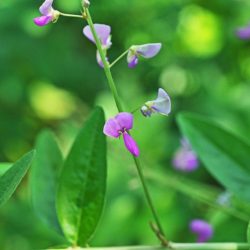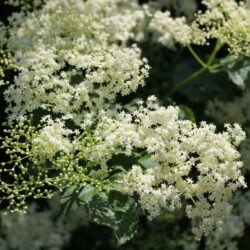The etymological origin of sweet clover comes from the Greek meli, meaning honey, and lôtos, for lotus, i.e. honey flowers. In fact, the plant is a melliferous plant, much sought-after by bees. Melilotus officinalis is the species used medicinally. However, related species such as M. alba Medicus are also used in herbal medicine.
What is sweet clover?
Sweet Clover or Yellow Clover (Melilotus officinalis), previously known as Melilotus arvensis Wallr. belongs to the Fabaceae family. This herbaceous plant is prized both as a fodder plant and as a honey plant. Its name, derived from the Greek “meli” (honey) and “lotos” (lotus), may evoke Dioscorides’ “trifoliate lotus”. Various vernacular names are attributed to it, such as Little Yellow Clover and Fleabane, and it is known by different names in several languages.
The plant is biennial and can grow to between 30 and 120 cm. It is distinguished by its straight stems and small, yellow flowers in clusters, blooming from June to October. The plant is also characterised by its leaves, made up of three toothed leaflets, and its fruit – straight, blackish-green pods. Its high coumarin content gives it a pleasant scent.
Common in Europe and Asia, sweet clover grows mainly in temperate regions. The flowering parts, harvested in summer and dried, are used to treat various ailments, including venous insufficiency (heavy legs, varicose veins, haemorrhoids) and to stimulate lymphatic circulation.
The antispasmodic properties of sweet clover are beneficial in cases of difficult digestion, bloating and flatulence. Traditionally, it has been used as a diuretic, applied topically to treat bruises, contusions and insect bites. It may also be recommended for soothing mild sleep disorders associated with nervousness.
A little history
In an old astrological treatise written in Greek, we find a plant for eyes and eye pain, triphullion (meaning “three leaves”). This astrological pamphlet indicates that triphullion is attributed to the sign of Taurus.
Dioscorides, like Pliny, refers to a plant as an ocular medicine. The Greek physician calls it lôtos (which some also call triphullion, he tells us). Pliny says it is good against urinary lithiasis, and the Corpus Hippocratum against fever, swollen wounds and difficult expectoration; it is also said to calm the “fury of drunkenness”.
In the early Renaissance, the Touraine apothecary Thibault Lespleigney (1496-1550) emphasised the anti-ophthalmic properties of sweet clover: “Let’s take the flower of sweet clover to remove heat and tears from the eyes”
What are the main pharmacological properties of sweet clover flowering tops?
Sweet clover is rich in coumarins, compounds known for their ability to inhibit blood coagulation. Among these coumarins, melilotoside is particularly noteworthy. These substances play a key role in sweet clover’s effectiveness against oedema. In addition, this plant contains flavonoids, which are thought to contribute to its protective effects on blood vessels.
Venolymphatic and capillary circulatory properties
Several clinical studies in the 1990s highlighted the action of coumarin derivatives, components of sweet clover, in reducing lymphoedema of the arms and legs. One of these was a double-blind, placebo-controlled study in 104 patients with chronic unilateral filarial lymphoedema (grades 1-2) or elephantiasis (grades 3-5) of the legs. The patients treated received a daily dose of coumarin for one year, and were reviewed twelve months later. The study therefore demonstrated the effect of coumarin in reducing lymphoedema. In several other studies, coumarin has also shown beneficial effects in the treatment of lymphoedema.
Lymphokinetic action
Sweet clover has a triple myotropic effect. It acts on the lymphatic system, veins and capillaries, strengthening the tone of these vessels. Firstly, it stimulates the lymphatic pump. This results in an increase in the frequency and strength of contractions, as well as a reduction in the excitability threshold. Secondly, sweet clover improves the efficiency of lymphatic contractions. Finally, it increases lymphatic vascular activity.
Coumarin extract of M. officinalis was effective in reducing post-mastectomy lymphoedema and lymphoedema following axillary curage for breast carcinoma. In 79% of patients, this treatment showed positive results over a 6-month period. This underlines its potential and possible use in this context, especially as a complement to physiotherapy such as manual lymphatic drainage. In another randomised, double-blind, parallel-group study of 77 women following breast cancer surgery and radiotherapy, the overall efficacy of coumarin was shown to be good or excellent.
The compound prevented the spontaneous tendency for arm lymphoedema to increase, with a reduction in the severity of local symptoms and an overall improvement in quality of life. This study is particularly interesting because it was carried out in patients who had undergone surgery and radiotherapy. Local irradiation has been shown to be the main risk factor for the development of lymphoedema
Capillary permeability, tissue trophic effect, anti-inflammatory action
This is achieved by increasing tissue oxygenation and improving microcirculation, as well as by stabilising the erythrocyte membrane.
In particular, this effect stimulates revascularisation mechanisms: the coumarin in sweet clover promotes healing and tissue regeneration, by stimulating the proteolytic power of macrophages and the reticuloendothelial system.
Sweet clover has powerful anti-oedematous properties. In vivo, in a model of acute inflammation, it ultimately reduces the activation of circulating phagocytes in a similar way to hydrocortisone hemisuccinate in sodium salt form.
Other properties
Sweet clover has various medicinal properties, acting as a sedative, mild analgesic and spasmolytic. It is also a mild anticoagulant and has antineoplastic and anti-ischaemic effects. Sweet clover has a notable antiviral action. It is effective against lymphatic insufficiency linked to venous and lymphatic disorders. This remedy tones the venous wall. It also contracts the muscle fibres around the vessels. It therefore has an anti-oedematous action against varicose veins. Sweet clover is also used for digestive and pelvic spasms. It relieves menstrual pain. It also helps soothe children suffering from sleep disorders.
Applied externally, sweet clover is effective for conjunctivitis. It can be applied topically or as an eye bath with its infusion. It is also beneficial for treating bruises, superficial haematomas and sprains.
Sweet clover has several therapeutic uses. It acts as a sedative antispasmodic, calming the sympathetic nervous system. Sweet clover is used to treat haemorrhoids. It also helps control hot flushes in perimenopausal women. It also has an anti-inflammatory action. It also helps prevent thrombo-embolic risks.
Other proven therapeutic indications include improving venous tone. Sweet clover facilitates blood circulation, helping to resorb lymphatic oedema, and has diuretic properties.
Are there any precautions to be taken when using Sweet Clover?
Melilot is not recommended for people suffering from liver disease or in cases of hypersensitivity to the active substances. The European Medicines Agency (EMA) does not recommend its use by pregnant or breast-feeding women, and extends this precaution to children and adolescents under the age of 18.
In terms of precautions for use, it is important to stop taking melilot 72 hours before surgery. Harvesting or using sweet clover yourself is risky because of the possibility of fermentation and mould. If mould develops, the 2-hydroxycinnamic acid contained in the plant can be transformed into dicoumarol, a powerful anticoagulant toxin that can cause internal haemorrhaging. It is therefore advisable to use an extract of the fresh, undried plant for safe use.
Sweet clover contains coumarins. These compounds can interact with anticoagulant plants and medicines. Patients taking anticoagulants, such as antivitamins K, must be closely monitored. They require medical monitoring of their INR. This monitoring is crucial when starting or stopping melilot-based treatment.
Adverse reactions reported with melilot include headaches, gastrointestinal problems and sometimes liver problems. Overdosage can lead to vomiting.
Although a clinical trial on pregnant women did not reveal any notable toxicity of sweet clover, the EMA advises against its use during pregnancy and breastfeeding. Finally, the EMA also advises against the use of sweet clover in people under the age of eighteen.
How should Melilot be taken and at what dosage?
Sweet clover is available in various forms, including dried flowers, capsules, and dry and liquid extracts. To prepare an infusion, use 1 to 2 g of dried flowers for 150 ml of boiling water, to be taken up to three times a day.
It is advisable not to harvest sweet clover yourself, as its coumarins can be converted into dicoumarol, a powerful anticoagulant, if stored incorrectly. This can lead to serious haemorrhagic accidents (bleeding).
- As a dietary supplement, in the form of fresh plant extract standardised into capsules.
- Standardised fresh plant extract: 5 to 10 ml per day in a glass of water.
- Hydroalcoholic extract: 25 drops 2 to 3 times a day in a glass of water.
- Herbal teas: 1 to 2 teaspoons of sweet clover per cup, steep for 5 to 10 minutes, 1 cup 2 to 3 times a day.
What do the health authorities think?
There have been four clinical studies involving almost 2,000 people showing that sweet clover is effective in treating the symptoms of venous insufficiency. In addition, two studies have shown that sweet clover can help reduce swelling of the arm (lymphoedema) following removal of lymph nodes from the armpit during treatment for breast cancer. However, the other proposed uses of sweet clover have not been scientifically proven.
Concerning the opinion of the health authorities:
- The European Medicines Agency (EMA) recognises the “traditionally established” use of sweet clover to relieve symptoms of leg heaviness associated with minor venous circulatory disorders and, in local applications, in the treatment of minor skin inflammations.
- Commission E of the German Ministry of Health recognises the use of sweet clover in the treatment of symptoms of venous insufficiency, and as an adjuvant treatment for phlebitis or haemorrhoid attacks. As a topical application, sweet clover is traditionally used to treat bruises and contusions.
- ESCOP (European Scientific Cooperation on Phytotherapy) recognises the use of sweet clover in the treatment of symptoms of venous insufficiency and varicose veins.
Medical literature and clinical trials
- Casley-Smith J.R. et al, Treatment of filarial lymphoedema and elephantiasis with 5,6-benzo-alpha-pyrone (coumarin), BMJ, 1993
- Hoult J.R. et al, Pharmacological and biochemical actions of simple coumarins: natural products with therapeutic potential, Gen Pharmacol, 1996
- Casley-Smith J.R. et al, Treatment of filarial lymphoedema of the arms and legs with 5,6-benzo-alpha-pyrone; N Engl. car J Med, 1993
- Plesca-Manea L. et al, Effect of Melilotus officinalis on acute inflammation, Phytotherapy Research, 2002
- Casley-Smith J.R. et al, Treatment of filarial lymphoedema by complex physical therapy, with and without oral and tropical benzopyrones: what should therapists and patients expect, Lymphology, 1996
- Farinola N. et al, Pharmacogenomics: it’s role in re-establishing coumarin as treatment for lymphedema, Lymphat. Res Biol, 2005
- Casley-Smith J.R., Benzopyrones in the treatment of lymphedema, Int Angiol, 1999
- Burgos A. et al, Comparative study of the clinical efficacy of two different coumarin dosages in the management of arm lymphedema after treatment for breast cancer, Lymphology, 1999
- Pastura G. et al, Lymphedema of the upper extremity in patients operated for a car cinoma of the breast; clinical experience with coumarinic extract from Melilotus officinalis, Clin Ter. 1999
- Földi-Börcsök E. et al, The anti-inflammatory and anti-edematous effects of coumarins from Melilotus officinalis. Arzneimittelforschung, 1971
- Coen J.J. et al, Risk of lymphedema after regional nodal irridation with breast conservation therapy; Int J Radiat Oncol Biol Phys, 2003





